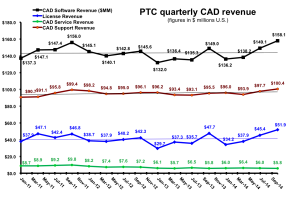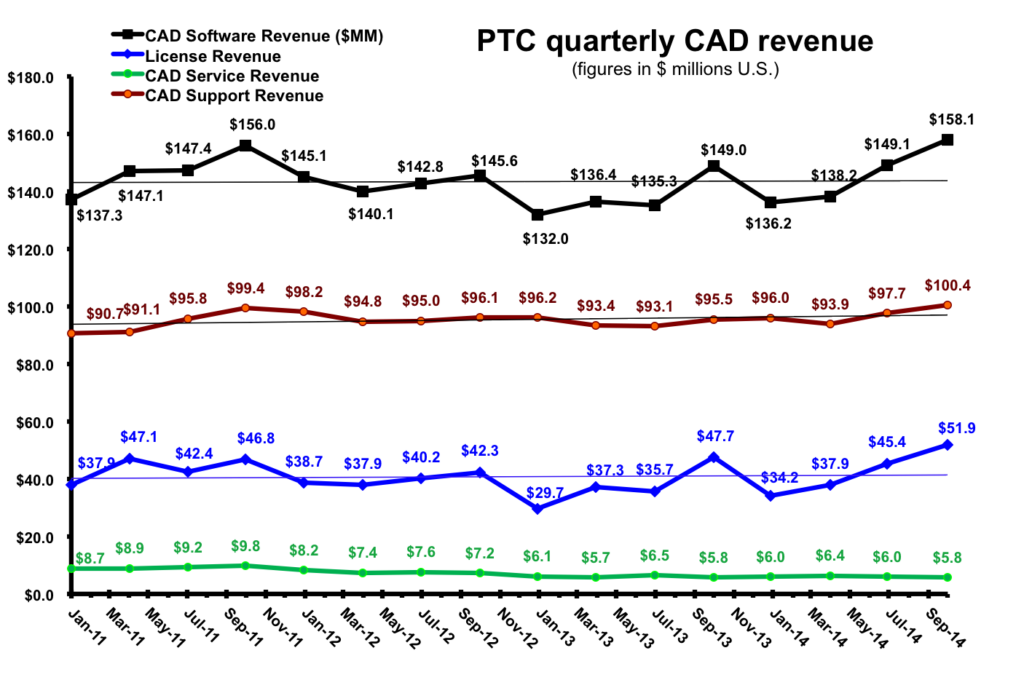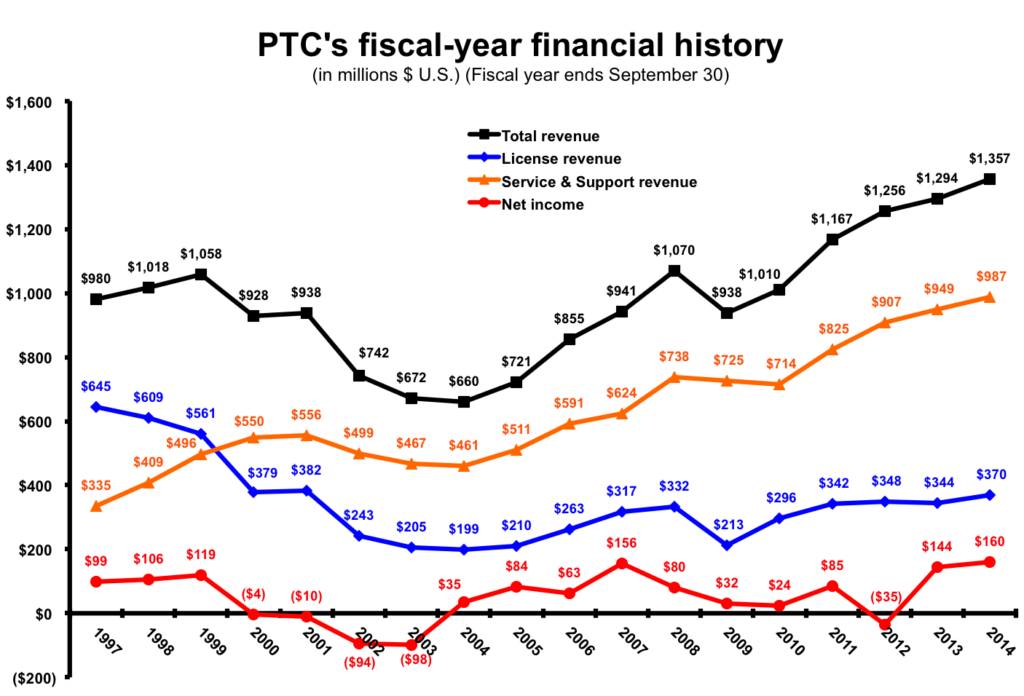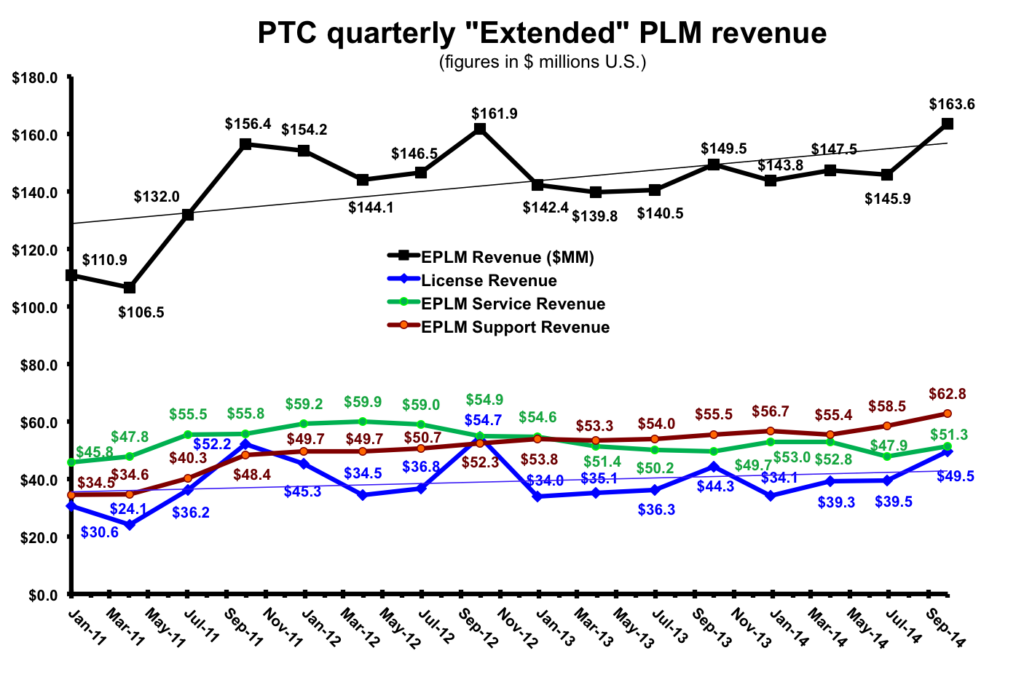PTC closed out its Fiscal Year with gains pretty much across the board and an optimistic CEO Jim Heppelmann says “I think we can put 2014 into the win column.”
By Kathleen Maher
PTC’s ongoing reinvention is going nicely thank you. The company reported increased revenues and income for their fiscal year 2014 and for the final quarter. The company reported revenue of $368 million for their fiscal fourth quarter. That’s a 7% increase over the same quarter last year. PTC says the revenue from its acquisitions including Enigma, NetIdeas, ThingWorx, Atego, and Axeda was $16 million. For the year the company reported revenue of $1.4 billion, a 5% increase over FY13. The company has seen good growth in its CAD segment and is optimistic about its SLM (services lifecycle management) business for the future. The company’s CAD license revenue was up 9% year over year for the quarter. The company’s Extended PLM business grew 11% year over year.

In his call with investors, PTC CEO Jim Heppelmann said their long range plan will enable them to deliver “superior earnings growth for 4 more years.” In the call, Heppelmann talked a great deal about the company’s SLM business, an opportunity the company sees growing as products are increasingly being developed with integrated connectivity. SLM, says Heppelmann, was the best performer for fiscal year 2013. The company believes their Internet of Things business will give them another source of opportunity for new business in the future.
When it comes to looking in the crystal ball, Heppelmann is cautious. He says the year had been uncertain because of shifting economic tides worldwide. The company believes that there is the potential for shifts in the coming year as well. PTC is seeing indications of a slowdown in manufacturing activity in Europe, Japan, and China. The effect he believes could be fewer large deals and megadeals for the company but “we are encouraged by an expanding pipeline of opportunities, particularly in our SLM & IoT businesses.”

On the topic of geographic revenue streams, Heppelmann notes that the fourth quarter looked a lot like the whole year with growth for the U.S. and Europe. Japan has slowed in response to currency fluctuations, and China is uncertain because of the “economic and political” situation. He describes those influences as “a strong headwind for us,” on his call to investors.
The company believes it is making good on promises made in 2009 when the company revamped its business. Back then, Heppelmann told investors the company pledged to deliver a 20% non-GAAP earning CAGR for five consecutive years. Over the first 4 years, he says, “we’ve actually delivered a 22% non-GAAP earnings CAGR.” The company has grown their non-GAAP operating income from $30 million a quarter to an average $70 million a quarter in 2013.
What do we think?
It has been impressive to watch PTC’s steady path since it has revamped its legacy CAD tools and added advanced capabilities and direct modeling. The company says that as customers make the transition from the older Windchill tools to the Creo 2 products, they often add modules and that is frequently their direct modeling products.
However, PTC’s transformation through acquisition is the really interesting story. As we’ve noted before, in this post recession era, no company selling software in design and manufacture can continue to do business as usual, and every company is taking their own course. PTC is building its business in services to complement product design and adjacent to that software for the Internet of Things. As Heppelmann and co-writer Michael E. Porter write in their Harvard Business Review article, “How Smart, Connected Products Are Transforming Competition,” the industry around product design and manufacture is experiencing a third wave of transformation that is creating a leap in functionality and performance for the products, and a new wave of productivity for the industry. The first wave, they write, was the move to digital design, the second was network connectivity, and for the third they say, “IT is becoming an integral part of the product itself.”
There is exuberance here, but the signs Heppelmann and Porter are reading are not wrong. We’re seeing the trends play out and if the company can hold the tiller on their core CAD and PLM business, and PTC continues to grow business from SLM and IoT, the company can meet the targets set by Heppelmann for the future through 2017. – K.M.
L. Stephen Wolfe, P.E., a contributing analyst for Jon Peddie Research, provided research and insight for this article. His charts are included in the body of this article and also below.









